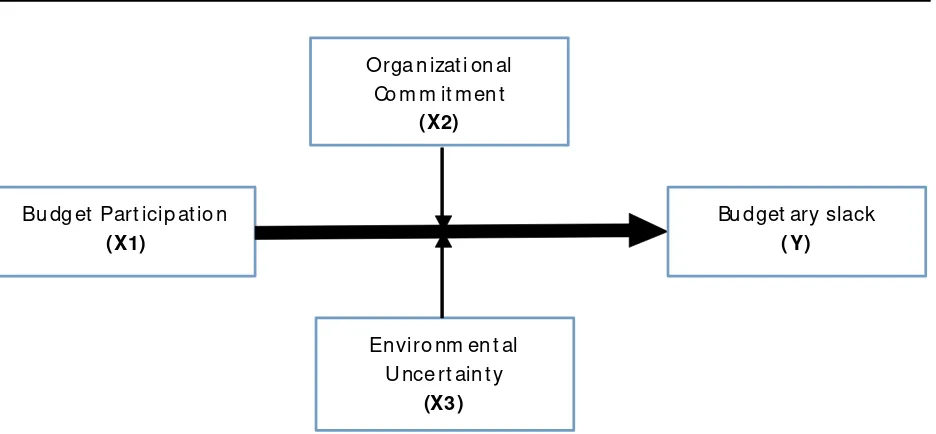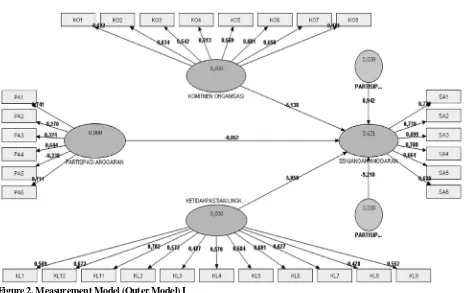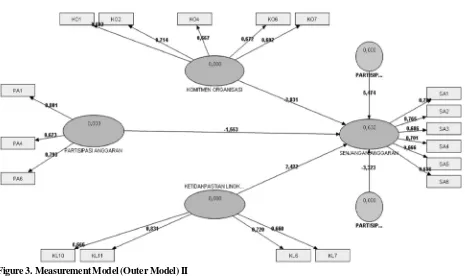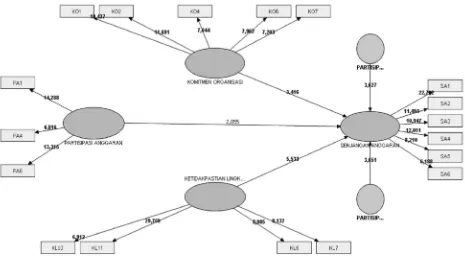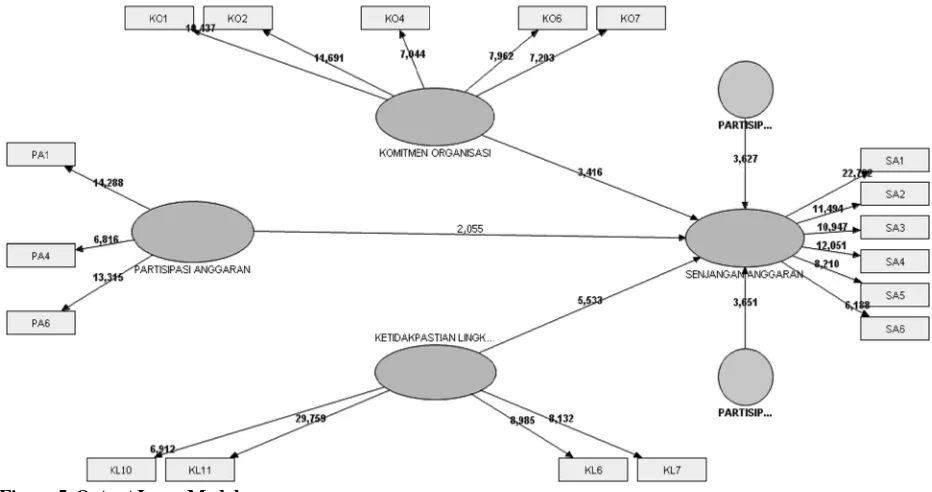Correspondention Author: Tun Huseno, Institut Pemerin-tahan Dalam Negeri (IPDN) , DOI: http://dx.doi.org/10.18 202jam23026332.15.1.13
JAM
15, 1
Received, December 20 16 Revised, February 2017 Accepted, March 20 17
ORGANIZATION COMMITMENT AND
ENVIRONMENTAL UNCERTAINTY MODERATING
BUDGET PARTICIPATION ON BUDGETARY SLACK
Tun Huseno
Program Study of Regional Finance, Institut Pemerintahan Dalam Negeri (IPDN)
Abstract: This research was conducted in order to determine the effect of budget participation, the budgetary slack, knowing the influence of organizational commitment moderates the effect of budget participation on budgetary slack, knowing the effect of moderating influence of environmental uncertainty budget participation on budgetary slack on the Government of West Sumatra Province. The sample in this study was 105 respondents and was taken by purposive sampling. The data used in this study are primary data, collected by surveying techniques by distributing questionnaires to each echelon III and IV in OPD Government of West Sumatra Province. The analysis technique used is the analysis of partial least square (PLS) based variance.The result of hypothesis analysis showed that budget participation and significant negative effect on the budgetary slack. Organizational commitment positively and significantly as a moderating budget participation on budgetary slack. Environmental uncer-tainties and significant negative effect as moderating budget participation on budgetary slack
Keywords: budget participation, organizational commitment, environmental uncertainty, bud-getary slack
Jurnal of Applied Management ( JAM) Volume 15 N umber 1, March 20 17
Indexed in Google Schola r
Budget is a plan about future activities that idenifies activi-ties to achieve goals. Budget is an element of management control system that serves as a planning and control tool, so that managers can carry out the organization’s activities more effectively and effi-ciently. As a planning tool, budget has an important role in the planning process to achieve the objectives of an organization. Budget is not only important for the private sector, but it is also important for the public sector. If the budget of private sector tends
considered to have tendency to slack is the budget participation. Participation of budgeting is the process which describes the individuals who are involved in the preparation of the budget and have an influence on the budget targets. The appreciation for the achievement of budget targets is requied. The process of budget participation is quite due to an effective exchange of information so that the amount of the approved budget is the result of the expertise and personal knowledge of the budget maker who are close to the operating environment (Anthony and Govindarajan, 2006). In addition, there will be a negative behavior that could arise from the involvement of subordinates (agents) in the budget preparation, namely by creating budgetary slack. The results showed inconsistency between oneresearches one another, so it is suspected that there are other variables affecting the relationship between participation in the budget preparation with the possibility of budgetary slack. Suggests that the difference in results of those studies can be overcomethrough a contingency approach. This is done by incorporating other variables that may affect the relationship of participation and budgetary slack. In this study, the variables which are proposed are variable of organizational commitment and environmental uncertainty as moderating variable. The reason why the variable of organizational commitment is chosen in this study is because organizational commitment shows the confidence and strong support to the values and goals which want to be achieved by organization. Strong organizational commitment in individuals will lead them to struggle to achieve the organization’s objectives in accordance with the purpose of the interest that has been planned, so the budgetary slack can be avoided (Porter, et al., 1974). Subordinates who have high level of organizational commitment will have a more positive view and try to do their best for the sake of the organization (Porter, et al., 1974). Conversely, individuals with low commitment will be selfish or more prioritize their own group. They have no desire to make the organiza-tion better, thus they lead to budgetary slack if they are involved in the budget preparation.
The difference of this study with the previous studies lies in the selection of moderating variable
that is used to replace the asymmetry information in the study with the variable of environmental uncertainty and keep using variable of organizational commitment as the moderating variable. Another difference is the place and time of the study, where this research raises the reality of budgetary slack phenomenon that occurs in West Sumatra Provincial Government, while the research conducted was in the Local Government of Dompu Regency. While the similarity lies in the technique of data analysis, which was by using Partial Least Square (PLS) analysis.
Based on the description above, this study examines the effect of budget participation on budgetary slack with organizational commitment and environmental uncertainty as moderating variables on the West Sumatra Provincial Government. The conceptual framework of this research is presented in Figure 1 below.
LITERATUR REVIEW AND HYPOTHESIS
Agency Theory
Agency theory which was described by Anthony and Govindarajan (2006) is a phenomenon that occurs ifleaders delegate authority to their subordinates to perform an authority or duty in making decisions. The relationship of agency in the context of local govern-ment is between the leaders and subordinates, in which subordinates do the planning process, implemen-tation, and reporting the local budgets by forming a Local Government Budget Team (TAPD), while the leaders play their role as supervisors. According to this theory, the relationship between subordinates and leaders basically is often in the opposite side because of the different interests.
Budgetary Slack
The concept of budgetary slack can also be explained by the agency theory or agency theory approach. In the agency relationship, there are two parties who make an agreement,the one who givesauthorithy is called principal, and the one who accepts the authority is called agent. In the agency relationship in government between executive and legislative, executive is the agent and legislative is the principal. Based on the explanation above, it can be concluded that budgetary slack is the difference between the budgets that has been planned with the actual implementation.
Budget Participation
Budget participation can also be explained by agency theory. The main principle of this theory is stating thatthere is working relationship between the parties that give the authority (principal) and the parties that receive the authority (agent). Based on agency theory, in local government, participatory bud-get is a process of cooperation between agents and principals in making decisions related to budgeting. Based on some of the definitions of budget tion above, it can be concluded that budget participa-tion is the involvement of individuals in the budget preparation process, and will affect the budget that will be generated. High participation in the budgeting
process will provide greater opportunities to subordi-nates to do budgetary slack. Conversely, if the partici-pation of subordinates is low, their expectation to do budgetary slack is restricted.So that the budgetary slack is also low (Edfan, 2002). Based on the explana-tion above, a hypothesis is proposed as follows:
H1 : Budget participation affects the budgetary slack.
The Ability of Organizational Commitment to
Moderate Budget Participation on Budgetary
Slack
Organizational commitment shows attachment level of individuals to an organization that is reflected by the belief and keeping their involvement in the organization (Soejoso, 2004). This illustrates that employees who have high organizational commitment will use the budget to achieve organizational goals. Meanwhile, employees with low organizational commitment will use the budget to pursue their own interests.
H2 : Organizational Commitment Moderates In-fluence of Budget Participation on Budget-ary Slack
Figure 1. Conceptual Framework of Research
Bu dg et Part icip at io n
(X1)
En viro nm en t al Unce rt ain t y
(X3 )
Orga n izat i on al Co m m it m en t
(X2)
Bu d get ary slack
The Ability of Environmental Uncertainty to
Moderate Budget Participation on Budgetary
Slack
Environmental uncertainty is one thing that becomes obstacle in the budget preparation. High environmental uncertainty reduces the individual’s ability to accurately predict the environment and can give impact on the budgetary slack. Although the information is easily obtained at low uncertainty, analytical skill remains limited. In low environmental uncertainty condition, high participation of subordi-natescan create budgetary slack. Based on the explanation above, a hypothesis is proposed as follows:
H3 : Environmental Uncertainty Moderates the In-fluence of Budget Participation on Budgetary Slack
RESEARCH METHOD
Population andSampleof Research
The population in this study included echelon II, III and IV in 10 OPD of West Sumatra Provincial Government. The sampling technique was conducted by purposive sampling method, based on the consideration that the respondentsare technical officials who are directly involved in budget preparation. The number of sample was 105 respondents.
Data Analysis
In this study, the data was collected by field survey, which was by sending questionnaires. Data was collected by distributing questionnaires directly to respondents as the research samples. Number of questionnaires distributed was 140 questionnaires. From 140 questionnaires, 105 questionnaires were returned, complete, and could be processed. This study usedmoderating variable of decentralized structure to determine the direct influence of the variable of budget participation (exogenous) on the variable of budgetary slack (endogenous) in Government of West Sumatra Province. The analysis in this study used
SEM Partial Least Square (PLS) method, based on variance.
FINDINGS ANDDISCUSSIONS
Evaluation of Measurement Model (Outer
Model)
Measurement model was used to test the construct validity and reliability of the research instruments, namely the questionnaires which were distributed to the samples. The validity test of this research were convergent validity and discriminant validity, whereas the reliability test wascomposite reliability.
Validity Test
The validity test of construct indicators is doneby convergent validity and discriminant validity. Convergent validity of the measurement model is with the reflexive of value indicator based on the correlation between item score/component score and construct score which is calculated by PLS (Ghozali, 2008:24). The same thing was also stated by Hartono (2011), convergent validity test in the PLS with reflective indicator is assessed based on the loading factor (correlation between score item/component score and the construct score) of indicators that measure the construct. The analysis result of the can be seen in Figure 2 below.
The value ofloading factor should be above 0.6 for exploratory research, but for loading factor value between 0.5-0.6 is still acceptable (Chin, 1998). By using loading factor value with limit of 0.6, then the indicatorsthat can be declared invalid are KL1, KL2, KL3, KL4, KL5, KL8, KL9, KO3, KO5, KO8, PA2, PA3, and PA5. Therefore, indicator KL1, KL2, KL3, KL4, KL5, KL8, KL9, KO3, KO5, KO8, PA2, PA3, PA5 whose value <0.60 should be dropped (discarded) from the model as shown in Table 1 below.
Figure 2. Measurement Model (Outer Model) I
Indicator Loading Factor < 0.60 Information
KL1 0.568886 drop
KL2 0.572111 drop
KL3 0.427129 drop
KL4 0.569873 drop
KL5 0.584070 drop
KL8 0.477928 drop
KL9 0.552077 drop
KO3 0.542163 drop
KO5 0.568743 drop
KO8 0.470683 drop
PA2 -0.269650 drop
PA3 0.324297 drop
PA5 -0.337970 drop
Table 1. Analysis Result of Loading Factor Indicators < 0.60
Source: Data Processed by SmartPLS (2016)
analyzed. The results of the analysis can be seen in Figure 3 below.
After doing re-testing, the value of loading factor above 0.6 was produced, and the lowest value was 0.601539, which was the loading factor of indicator KO7 in the variable of organizational commitment. The results showed that all indicators have been able to form addressedvariables well, and the indicators
used were valid and have met convergent validity. Another method to see the discriminant validity is by comparing the value of square root of average variance extracted (AVE) of each construct with the correlation between one construct with other constructs in the model. In this study, the method used was bylooking at the value of cross loading. Based on the value of cross loading for all constructs which> 0.60,therefore, it metthe term of discriminant validity. The recommended value is above 0.5. AVE value can be seen Table 4 below.
From Table 4 above,it was obtained AVE value above 0.5 for all variables contained in the research model. The lowest value of AVE was equal to 0.502566 on external factor variable. These results indicate that the indicator is valid in shaping the variable in question.
Reliability Test
reliability value is equal to 0.801081 on the variable of budget participation.
Structural Model Test (Inner
Model)
After the model which was estimated met Outer Model criteria, thenstructural model test (Inner model) was performed. Evaluation of inner modelwas done by bootstrapping test. Evaluation of structural model (inner model) was structural to predict causal relationship between the latent variable through bootstrapping test to predict the causal relationship of structural model (inner model) which was evaluated by using R-Square as shown in Table 6 below. Figure 3. Measurement Model (Outer Model) II
research, composite reliability value of 0.6 is accep-table. Composite reliability value can be seen in Table 5 below.
Table 4. Average Variance Extracted (AVE)
Source: Output of Smart PLS Outer Model (Overview), 2016 AVE ENVIRONMENTAL UNCERTAINTY 0,52213 8
ORGANIZATIONAL COMMITMENT 0,54927 4
BUDGET PARTICIPATION 0,57456 0
BUDGET ARY SLACK 0,50256 6
Table 5. Composite Reliability
Source: Output of SmartPLS, Outer Model (Overview) (2016)
Composite Reliability
E NVIRONMENTAL UNCERTAINT Y 0,812438
ORGANIZATIONAL COMMITMENT 0,802608
BUDGET PARTICIPATION 0,801081
BUDGETARY SLACK 0,857712
Table 5 above shows that the composite reliability value of for all variables is above 0.6, which indicates that all constructs in the estimated model meet the
Table 6. R square
Source: Output of SmartPLS, Outer Model (Overview)
R Square
ENVIRONMENTAL UNCERTAINTY
ORGANIZATIONAL COMMITMENT
BUDGET PARTICIPATION
BUDGETARY SLACK 0,632199
the variable of budgetary slack by 63.21%. The rest, 36.79%, is explained by other factors outside this study.
Hypothesis Test
After the analysis of the model was done, the next step washypothesis test. The analysis was done
by comparing the value of T-table with T-statistics value which were resulted from the bootstrapping processin PLS. The hypothesis is accepted if the value of T-statistics is higher than the value of T-table (1.95) with the level of significance of 5%. The result of PLS bootstrapping process can be seen in Figure 4 and Table 7 below.
Table 7. Result Direct Effectof Hypothesis Test (Output Inner Model)
Source: Output of Inner Model Smart PLS (2016) Variable Original
Sample (O)
Sample Mean (M)
Standard Deviation (STDEV)
Standard Error (STERR)
T Statistics (|O/STERR|)
BUDGET
PA RTICIPATION ->BUDGETARY SLA CK
-1,552 660 -0,986576 0,755616 0,755616 2,054826
BUDGET
PA RTICIPATION * ENVIRONMENTAL UNCERTAINTY ->BUDGETARY SLA CK
-3,323 037 -2,810450 0,910128 0,910128 3,651176
BUDGET
PA RTICIPATION * ORGANIZATIONAL COMMITMENT ->BUDGETARY SLA CK
5,473558 4,075098 1,509307 1,509307 3,626536
Test of the Influence of Budget Participation
on Budgetary Slack
Based on the analysis result in Table 8, Hypo-thesis 1 states that budget participation gives significant effect on budgetary slack. Hypothesis test results show path coefficient between budget partici-pation and budgetary slack, which value of T-statistics (2.054826) > T-table (1.95) with level of significance of 5%, indicating that the budget participation gives significant effect on budgetary slack. Thus the first hypothesis is accepted. The value of original sample estimate is negative by -1.552660, which shows nega-tive direction of the relationship between budget participation and budgetary slack. This means that the higher the level of participation in the budget prepa-ration, the tendency of budgetary slack declines. High budget participation makes employees optimize their productive capability. This ultimately leads to a decrease in budgetary slack between subordinates and leaders. This is clearly a positive effect on an organization because cooperation between subordi-nates and leaders becomes harmonious.One appropriate effort to decrease the budgetary slack is involving several subordinates to participate directly in the budget preparation. It can foster a sense of community among employees so that high budgetary slack can be minimized. These results are consistent with the results of studies conducted by Lowe and Shaw (1968), Lukka (1988), Young (1985), Amrul and Nasir (2002), and Yuwono (1999). The increase of tendency to create budgetary slack is in line with the increase in the participation rate, which shows a dysfunctional behavior of the use of participatory budget.
Test of Organizational Commitment
Moderat-ing the Influence of Budget Participation on
Budgetary Slack
Based on the analysis result in Table 8, Hypothe-sis 2 states that Organizational Commitment Moderates the Influence of Budget Participation on Budgetary Slack. Hypothesis test results show path coefficient between Organizational Commitment Moderates the Influence of Budget Participation on Budgetary Slack has T-statistics value of (3.626536)> T-table (1.95) with the level of significance of 5%. It
indicates that organizational commitment moderates the effect of budget participation on budgetary slack; therefore, hypothesis 2 is accepted. The value of the original sample estimate is 5.473558. Therefore, the organizational commitment can play a role as a moderating variable affecting the relationship between budget participation and budgetary slack. Based on these results, it appears that in Government of West Sumatra Province, which is the object of research, there was found that organizational commitment has significant negative impact on the relationship between budget participation and budgetary slack. Organizational commitment can grow because people have an emotional attachment to the organization, which includes moral support and accepting the existing value as well as the determination of people to do something in order to support the success of the organization, in accordance with the objectives and prioritize the interests of the organization compared to their own interests. In this view, individuals who have a high commitment will prioritize the interests of the organization than personal or group interests. This result is consistent with the result of research conducted by Yuwono (1999). This result is not sistent with the result of research which was con-ducted byNouri and Parker (1996), who took a sample of managers of chemical companies in the United States. Nouri and Parker concluded that the relationship between budget participation and budgetary slack is moderated by organizational commitment.
Test of Environmental Uncertainty
Moderat-ing the Influence of Budget Participation on
Budgetary Slack
the relationship between budget participation and budgetary slack. The results of this study support hypothesis 3, in which the environmental uncertainty can act as a moderating variable on the relationship between budget participation and budgetary slack. Based on these results, it appears that in Government of West Sumatra Province, who became the object being studied, it was found that the environmental uncertainty has a significant influence on the relation-ship between budget participation and budgetary slack. The results of this study are consistent with the results of research conducted by Govindarajan (1986), Amrul and Nasir (2002), and Yuwono (1999). Govindarajan (1986) argues that the level of budget participation would have a positive influence on budgetary slack. In a low environmental uncertainty, the higher the participation, the higherthe budgetary slack. Conversely,budget participation will have a negative influence on budgetary slack inhigh environ-mental uncertainty. A subordinate who has high participation in budget and faces low environmental uncertainty will be able to create budgetary slack because he/she can deal with uncertainty and can predict the future. In contrast, the high degree of uncertainty, it will be increasingly difficult to predict the future and create budgetary slack.The following
is the output inner based on output with SmartPLS 3 Version 2.
CONCLUSION
Budget Participation has a negative and signifi-cant effect on the budgetary slack in the Government of West Sumatra Province. Thus, the involvement of subordinates in the budgeting process decreases the tendency of budgetary slack of the Government of West Sumatra Province. Organizational commitment can moderate the effect of budget participation on budgetary slack. Thus, organizational commitment can be a moderating between budget participation with budgetary slack in the Government of West Sumatra Province. Environmental uncertainty can moderatethe influence of budget participation on budgetary slack. Thus, the environmental uncertainty can be a moderating between budget participation and budgetary slack on the Government of West Sumatra Province.
SUGGESTION
Based on the analysis and conclusions obtained, the suggestions which may be proposedboth for the Government of West Sumatra Province and for further
researches are budgetary slack should be predicted and controlled from an early age in order to improve the effectiveness of budget because budgetary slack makes human resources not utilized maximally in SKPD West Sumatra Provincial Government, In budget preparation, the real concept of participation should be created, not only pseudo participation, so that the tendency of budgetary slack can be minimized, The Government of West Sumatra Province needs to increase the commitment of subordinates, namely by increasing the sense of belonging. With a sense of belonging, the subordinates will assume that any kind of damages suffered by the Government of West Sumatra province is a loss for them as well, Research on the same aspects to determine the consistency of the results of this study is still required, and Further research is required to examine the moderating effect by using variables such as work engagement, budget accuracy, and information related to the task (job relevant information).
REFERENCES
Adisaputro dan Asri. 1996. Penganggaran Perusahaan. Yogyakarta: Penerbit BPFE.
Anthony, Robert, and Vijay Govindarajan. 2006.”Sistem Pengendalian Manajemen”, terjemahan FX. Kurniawan Tjakrawala. Jakarta: SalembaEmpat. Arfan Ikhsan Lubis. 2010. Akuntansi Keperilakuan, Edisi
2. Jakarta: Salemba Empat.
Bastian, Indra. 2006. Akuntansi Sektor Publik: Suatu Pengantar. Jakarta: Erlangga.
Brownell, Petter. 1982. The Role of Accounting Data in Performance Evaluation, Budgetary Partisipative, and Organizational Effectiveness. Journal of Accounting Research, Vol. 20, pp. 12-27
Darlis, Edfan, 2002, Analisis Pengaruh Komitmen Organisasional dan ketidakpastian Lingkungan terh adap Hubungan antara Partisipasi Anggaran dengan Senjangan Anggaran, Jurnal Riset Akuntansi Indonesia, Vol. 5, No. 1, Hal 85-100 Universitas Riau Dwir andr a, A.A.N.B. 2006. Pen gar uh In ter aksi
ketidakpastian Lingkungan, Desentralisasi, dan Agregat Informasi Akuntansi Manajemen Terhadap
Kinerja Manajerial. . Bali: Fakultas
Ekonomi-Universitas Udayana.
Dwisariasih, Jivi. “PengaruhAsimetriInformasi, Budaya Organisasi dan Kohesivitas Kelompok terhadap hubungan Partisipasi Anggaran dan Kesenjangan Anggaran (Studi Empiris pada seluruh SKPD di kota Padang)”. Jurnal. S-1 UNP. 2013.
Ghozali, I. 2011. AplikasiAnalisis Multivariate dengan Program SPSS 19.Edisi Kelima. Semarang: Penerbit Universitas Diponegoro.
Govindarajan, V. 2003. Sistem Pengendalian Manajemen. Edisi Pertama. Jakarta: SalembaEmpat.
Hansen and Mowen, 2009. Akuntansi Manajamen. Jakarta: Salemba Empat.
Hasibuan, M.S.P. 2005. Manajemen Sumberdaya
Manusia. Edisi Revisi. Jakarta: PT. BumiAksara. Jogiyanto. 2010. MetodePenelitianBisnis: Salah Kaprah dan
Pengalaman-Pengalaman. Yogyakarta: Penerbit BPFE. Mardiasmo. 2002. Akuntansi Sektor Publik. Yogyakarta:
Andi Offset.
Miah, N.Z., dan Mia, L. 1996.Desentralisation, Account-ing Control and Performance of Government Organi-zation: A New Zealand Empirical Study. Financial Accountability and Management Vol. 12. No. 3:173-89.
Mowen, J.C. 1997. AkuntansiManajemen, EdisiKedua, terjemahan: A. Hermawan. Jakarta: PenerbitErlangga. Mulyadi.2001. AkuntansiManajemen; Konsep, Manfaat dan Rekayasa, Cetakan Keempat. Jakarta: Penerbit Salemba Empat.
Nurcahyani, K. 2010. PengaruhPartisipasi Anggaran terhadap Kinerja Manajerial Melalui Komitmen Organisasi dan Persepsi Inovasi SebagaiVariabel In-tervening. Skripsi. Semarang: Fakultas Ekonomi Uni-versitas Diponegoro.
Latuheru, Belianus Patria, 2005, Pengaruh Partisipasi Anggaran terhadap Senjangan Anggaran dengan Komitmen Organisasi sebagai Variabel Moderating (Studi Empiris pada Kawasan Industri Maluku), Jurnal Akuntansi dan Keuangan, Vol. 7, No. 2 Hal 117-130, Fakultas Ekonomi Universitas Kristen Petra. Porter, L.W., R.M. Steers, R.T. Mowdey, dan P.V. Boulin. 1974. “Organizational Comitment, Job Satusfaction, and Turn Over Among PsyatricTehnicians”. Journal of Applied Psychology 59. Pp. 603-609
